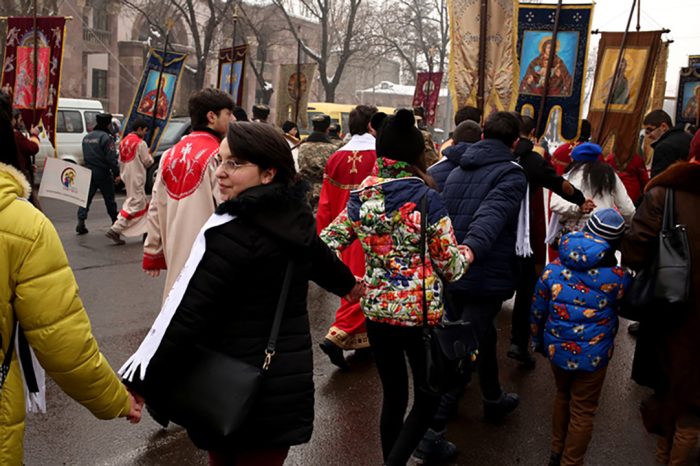TOURINFO-January 27, 2023–Every passing year, the Armenian community eagerly anticipates the joyous celebration of St. Sarkis Day, a revered figure in Armenian Christian tradition synonymous with love and protection. While not explicitly identified as the Armenian equivalent of Valentine’s Day, St. Sarkis’ Day shares some similarities, as it is a day when Armenians traditionally celebrate love and romance. The feast day falls between January 11 and February 15th or 63 days before Easter on Saturday. This year, in 2024, the celebration holds even more significance as Armenians worldwide prepare to commemorate St. Sarkis Day on January 27th, a date that weaves together centuries-old traditions with contemporary celebrations.
 Legends of St. Sarkis: A Tale of Miracles and Love
Legends of St. Sarkis: A Tale of Miracles and Love
Embedded within the cultural fabric of Armenia are numerous legends surrounding St. Sarkis, with the most widely shared narrative portraying him as Sergius, a Roman commander turned miracle worker. The legend unfolds dramatically as Sarkis, along with his 40 soldiers, achieves an extraordinary victory against an enemy tenfold in size. However, their triumph turns into a perilous encounter when, after a victorious feast, they fall victim to trickery and intoxication by a Persian ruler.
In a captivating twist, damsels are ordered to kill the sleeping soldiers, yet one, enchanted by Sarkis, disobeys and chooses to kiss him instead. Awakened and distraught, Sarkis flees on his white horse, symbolizing love in Armenian tradition. This poignant tale of love, sacrifice, and miraculous escape has become an integral part of St. Sarkis Day celebrations.
 Aghablit: Unveiling Dreams of Love
Aghablit: Unveiling Dreams of Love
Adding a layer of enchantment to the celebration, Armenians partake in the tradition of eating “Aghablit” on the eve of St. Sarkis Day. The “aghie blit,” a salty cookie, is savored by unmarried youth the night before the feast, hoping to catch a glimpse of their future bride or groom in their dreams. fostering dreams of their future spouse. Placing trays of flour on rooftops is common practice, they await the supposed footprint of St. Sarkis’s horse, believing it to be a harbinger of their dreams coming to fruition.

 A Flexible Date with Significance
A Flexible Date with Significance
Unlike the fixed date of February 14 for Valentine’s Day, the Feast of St. Sarkis is celebrated between January 11 and February 15, occurring 9 weeks before Easter. This flexibility adds a unique dimension to the celebration, allowing Armenians to partake in the beauty of traditions across various regions.
On St. Sarkis’ Day, young Armenians engage in a symphony of customs to seek blessings for a happy and loving marriage. Church services, where prayers for guidance and blessings are offered, set the spiritual tone. Candle lighting, symbolizing hope, and offerings at the church further enrich the experience.
In contemporary times, St. Sarkis’ Day has embraced elements of Western traditions like Valentine’s Day. Some Armenians exchange cards, flowers, and gifts on February 14, seamlessly blending global practices with the rich tapestry of traditional celebrations. This harmonious fusion underscores the evolving nature of cultural festivities and infuses a contemporary flair into the age-old celebration of love.

Traditionally, on St. Sarkis’ Day, the streets of Yerevan come alive with a procession featuring a portrayal of St. Sarkis, sitting on his majestic horse, accompanied by priests and flags. This captivating sight symbolizes love and devotion, capturing the essence of the legend. The culmination occurs at Lover’s Park, where the celebrations extend throughout the day, contributing to the vibrant tapestry of the occasion.

 St. Sarkis’ Day in Armenia is more than a celebration of love; it is a rich tapestry woven with traditions, legends, and customs that have stood the test of time. Seamlessly blending elements of Armenian Christian heritage with global influences, this celebration offers Armenians unique and heartfelt ways to express and celebrate love on this special day. As St. Sarkis Day approaches, Armenians worldwide eagerly anticipate the joyous festivities that will once again bring together the past, present, and future in a celebration that transcends time.
St. Sarkis’ Day in Armenia is more than a celebration of love; it is a rich tapestry woven with traditions, legends, and customs that have stood the test of time. Seamlessly blending elements of Armenian Christian heritage with global influences, this celebration offers Armenians unique and heartfelt ways to express and celebrate love on this special day. As St. Sarkis Day approaches, Armenians worldwide eagerly anticipate the joyous festivities that will once again bring together the past, present, and future in a celebration that transcends time.














